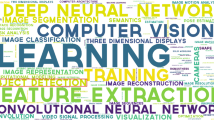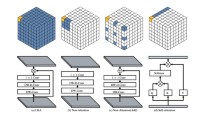Abstract
In this paper, the model and its curriculum learning method of garbage hierarchical classification and corresponding operation mode decision in home environment are proposed from the perspective of cleaning robot. In order to realize the hierarchical learning of garbage attribute concept, this paper designs a learning model with iterative feedback network as the backbone network. In the early stage of iteration, the model focuses on learning the state of garbage, in the middle stage, it focuses on the appearance attributes of garbage, and the specific categories of garbage in the later stage. At the same time, the attention module is introduced to achieve different levels of feature expression learning, which further improves the performance of the model. The evaluation was conducted on the collected garbage data set and the public CIFAR-100 and Stanford Cars data sets, which verified the effectiveness and wide applicability of the proposed method.








Similar content being viewed by others
References
Hayat A, Parween R, Mohan R, Parsuraman K, Kandasamy P (2019) Panthera: design of a reconfigurable pavement sweeping robot. In: Proceedings of the IEEE international conference on robotics and automation, pp. 7346–7352
Jeongmin J, Jung B, Koo J, Choi H, Moon H, Pintado A, Oh P (2017) Autonomous robotic street sweeping: initial attempt for curbside sweeping. In: Proceedings of the IEEE international conference on consumer electronics, pp. 72–73
Sun X, Zhao Y (2017) Research on the development status and trend of sweeper robots. Sci Technol Inf 15(28):238–239
Liu S, Li Z, Wang S, Li R (2016) Cognitive abilities of indoor robots. In: World congress on intelligent and automation, pp. 1508–1513
Frese U, Hirschmueller H (2015) Special issue on robot vision: what is robot vision. J Real-Time Image Proc 10(4):597–598
Abhijeet R, Ankit R, Michiko W, Yohei H (2019) An efficient algorithm for cleaning robots using vision sensors. In: 6th international electronic conference on sensors and applications, pp. 42–45
Yang J, Ma L, Bai D, Dong J (2012) Robot vision environmental perception method based on hybrid features. J Image Gr 1:114–122
Okarma K (2020) Applications of computer vision in automation and robotics. Appl Sci 10:6783
Ning K, Zhang D, Yin F, Xiao H (2019) Garbage detection and classification of intelligent sweeping robot based on visual perception. J Image Gr 24(8):1358–1368
Saif A, Gita S (2019) Customizing object detectors for indoor robots. In: Proceedings of the IEEE international conference on robotics and automation, pp. 8318–8324
Li Y, Zhang D, Yin F, Zhang Y (2020) Mode decision of indoor cleaning robot based on causal reasoning and attribute learning. IEEE Access 8:173376–173386
Bengio Y, Louradour J, Collobert R, Weston J (2009) Curriculum learning. In: Proceedings of the 26th annual international conference on machine learning., pp. 41–48
Ashford SJ, Cummings LL (1983) Feedback as an individual resource: personal strategies of creating information. Organ Behav Hum Perform 32(3):370–398
Pentina A, Sharmanska V, Lampert CH (2015) Curriculum learning of multiple tasks. In: Proceedings of the IEEE conference on computer vision and pattern recognition, pp. 5492–5500
Guo S, Huang W, Zhang H, Zhuang C, Dong D, Scott MR, Huang D (2018) Curriculumnet: weakly supervised learning from large-scale web images. In: Proceedings of the European conference on computer vision (ECCV), pp. 135–150
Liu X, Zhou F, Shen D, Wang S (2019) Deep convolutional neural networks with curriculum learning for facial expression recognition. In: 2019 Chinese control and decision conference (CCDC), June 2019, pp. 5925–5932
Wang Y, Gan W, Yang J, Wu W, Yan J (2019) Dynamic curriculum learning for imbalanced data classification. In: Proceedings of the IEEE international conference on computer vision, pp. 5017–5026
Li Z, Yang J, Liu Z, Yang X, Jeon G, Wu W (2019) Feedback network for image super-resolution. In: Proceedings of the IEEE conference on computer vision and pattern recognition, pp. 3867–3876
Li Q, Li Z, Lu L, Jeon G, Liu K, Yang X (2019) Gated multiple feedback network for image super-resolution. arXiv preprint: 1907.04253
Zamir AR, Wu TL, Sun L, Shen WB, Shi BE, Malik J, Savarese S (2017) Feedback networks. In: Proceedings of the IEEE conference on computer vision and pattern recognition, pp. 1308–1317
Jaderberg M, Simonyan K, Zisserman A (2015) Spatial transformer networks. In: Advances in neural information processing systems(NIPS), pp. 2017–2025
Hu J, Shen L, Sun G (2018) Squeeze-and-excitation networks. In: Proceedings of the IEEE conference on computer vision and pattern recognition, pp. 7132–7141
Wang F, Jiang M, Qian C, Yang S, Li C, Zhang H, Tang X (2017) Residual attention network for image classification. In: Proceedings of the IEEE conference on computer vision and pattern recognition, pp. 3156–3164
Woo S, Park J, Lee JY, So Kweon I (2018) Cbam: convolutional block attention module. In: Proceedings of the European conference on computer vision (ECCV), pp. 3–19
Ning K, Zhang DB, Yin F, Xiao HH (2019) Garbage detection and classification of intelligent sweeping robot based on visual perception. J Image Gr 24(8):1358–1368
Krizhevsky A, Hinton G (2012) Learning multiple layers of features from tiny images. In: Advances in neural information processing systems(NIPS), pp. 1106–1114
Krause J, Stark M, Deng J, FeiFei L (2013) 3d object representations for fine-grained categorization. In: Proceedings of the IEEE international conference on computer vision workshops, pp. 554–561
Simonyan K, Zisserman A (2014) Very deep convolutional networks for large-scale image recognition. arXiv preprint: 1409.1556
He K, Zhang X, Ren S, Sun J (2016) Deep residual learning for image recognition. In: Proceedings of the IEEE conference on computer vision and pattern recognition, pp. 770–778
Funding
This work was supported by Key Project of Guangdong Fundamental and Application Fundamental Research Joint Fund [2020B1515120050] and the Joint Fund for Regional Innovation and Development of NSFC under [Grant U19A2083]; and the Science and Technology Research and Major Achievements Transformation Project of Strategic Emerging Industries in Hunan Province under [Grant 2019GK4007]; And it was supported by Natural Science Foundation of Hunan Province under [Grant 2020JJ4090 and 2020JJ4588].
Author information
Authors and Affiliations
Contributions
All authors contributed to the study conception and design. Material preparation, data collection and analysis were performed by Dongbo Zhang, Panbo Fu, Feng Yin, and Hongzhong Tang. The first draft of the manuscript was written by Panbo Fu. All authors read and approved the manuscript.
Corresponding author
Ethics declarations
Conflict of interest
The authors declare that we have no known competing financial interests or personal relationships that could have appeared to influence the work reported in this paper.
Additional information
Publisher's Note
Springer Nature remains neutral with regard to jurisdictional claims in published maps and institutional affiliations.
Rights and permissions
About this article
Cite this article
Fu, P., Zhang, D., Yin, F. et al. The multi-mode operation decision of cleaning robot based on curriculum learning strategy and feedback network. Neural Comput & Applic 34, 9955–9966 (2022). https://doi.org/10.1007/s00521-022-06980-5
Received:
Accepted:
Published:
Issue Date:
DOI: https://doi.org/10.1007/s00521-022-06980-5




